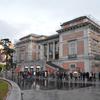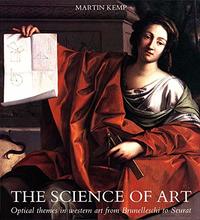More about Las Meninas
- All
- Info
- Shop

Contributor
King Philip was like “Diego, my main man! Wanna paint my family portrait? Velázquez was like, “Heck ya, but wait... lemme take a selfie.”
This image is so layered with enigmatic meaning that it’s kept art historians scratching their domes for centuries. Brainiacs are entranced. Famous philosopher/leather-daddy Michel Foucault wrote about it. Pablo Picasso created a whopping 58 reproductions of the scene and even wackjob Salvador Dalí did a version where he replaced all the people with numbers.
You can call it a self-portrait, a family portrait, a royal portrait, a scene of 17th century Spanish court life, or just a really trippy picture that messes with the conventions of pictorial space. People judge it as Velasquez’s crowning glory in terms of what painting itself is able to achieve… but I like to judge famous paintings on their power to inspire parodies featuring the cast of The Simpsons. (Google it).
The title means “maids of honor”, which refers to the ladies in waiting surrounding the little girl in the center who has been identified as Princess Margarita. Blended, no salt. Other members of her entourage are her favorite companions, a large dog, a woman in black, and a Shakespeare-looking dude looming creepily in the distant doorway. Velasquez himself is featured in the foreground, painting upon a large canvas, with a killer ‘stache.
The man with the money is always included and you can see King Philip and his wife hovering in what appears to be a mirror near the doorway. Or is it a painting in a painting? Inception! Little things like the reflections and doorways create visual extensions in the image that cause the viewer to swing between reality and illusion. Even though there’s nothing scandalous going on, I can’t help but feel a Big Brother-type sense of foreboding, as though I’m the one being watched instead of watching.
This precious pearl of Western art history was almost lost in a fire in 1734. Since then it’s undergone several restorations. The most recent one in 1984 cleaned up the layer of filth on the painting, but actually caused outrage because it made the painting “look different”. Different or not, since its creation Las Meninas continues to work its magic on the world

Contributor
Theorize with the masses in front of Velázquez's Maids of Honor.
It wasn't even known as The Maids of Honor or Las Meninas until 1843. Previously used titles include The Family of Philip IV, The Royal Family, and Velázquez and the Royal Family.
There are a bunch of theories about the real subject of this painting, because what else do historians have to do? Is Velázquez, as the court painter for Philip IV, painting the King and Queen (as seen at the back of the room in the mirror reflection) or is he painting the Infant Margaret Theresa with King and Queen watching? Or maybe that isn’t even a mirror but a portrait hanging. Is the viewer actually the King and Queen? Or are Mariana and Philip about to post to Instagram? #GettingPortraitDoneByDVquez #RoyalSelfie #IsMyTiaraOnStraight #MeAndMyMan
Jan van Eyck’s Arnolfini Portrait was in Phillip’s castle and Velázquez probably thought, “Cool mirror idea!” It also shows up in his Toilet of Venus (Rockeby Venus) at the National Gallery.
The cross on Velázquez's shirt/smock wasn't added until sometime after 1659. It denotes that Velázquez is part of the Order of Santiago, which requires getting through a whole lot of red tape and a lot of friends to bear witness.
The people of short stature were Margaret’s “playmates”. There were no other children in the palace, so little people were used as pint-sized company for royal children. One of them lovingly abuses the pet dog.
And if you think little Miss Margarita is a little off looking, it’s just the unfortunate facial structure she inherited from her father. Those Phillip Habsburgs were lookers! Maybe Jay Leno and Rumer Willis are distant relations?
The painting was damaged, but also saved, when it was tossed from a window when the Alcazar (original Palacio Real) burned down in 1734. Now it resides center stage in El Museo Nacional del Prado but beware of the many large groups who want to theorize with their audio guides.
Because of all these visitors and pollution the painting gets dirty pretty fast. The last time it was cleaned (way back in 1983) people threw a hissy fit because conservators removed a layer of dirt and the yellow sheen it caused, which made the painting look different.
Unfortunately, due to it's massive size (125.2 in × 108.7 in) and importance, Las Meninas will never be coming to a town near you; you'll have to visit it.
Also, Picasso did a series of 58 versions of Las Meninas that can be seen in the Museu Picasso de Barcelona.
And don’t you just love his epic stache!?
Featured Content
Here is what Wikipedia says about Las Meninas
Las Meninas (Spanish for 'The Ladies-in-waiting'
pronounced [las meˈninas]) is a 1656 painting in the Museo del Prado in Madrid, by Diego Velázquez, the leading artist of the Spanish Baroque. It has become one of the most widely analyzed works in Western painting for the way its complex and enigmatic composition raises questions about reality and illusion, and for the uncertain relationship it creates between the viewer and the figures depicted.
The painting is believed by F. J. Sánchez Cantón to depict a room in the Royal Alcazar of Madrid during the reign of King Philip IV of Spain, and presents several figures, most identifiable from the Spanish court, captured in a particular moment as if in a snapshot. Some of the figures look out of the canvas towards the viewer, while others interact among themselves. The five-year-old Infanta Margaret Theresa is surrounded by her entourage of maids of honour, chaperone, bodyguard, two dwarfs and a dog. Just behind them, Velázquez portrays himself working at a large canvas. Velázquez looks outwards beyond the pictorial space to where a viewer of the painting would stand. In the background there is a mirror that reflects the upper bodies of the king and queen. They appear to be placed outside the picture space in a position similar to that of the viewer, although some scholars have speculated that their image is a reflection from the painting Velázquez is shown working on.
Las Meninas has long been recognised as one of the most important paintings in the history of Western art. The Baroque painter Luca Giordano said that it represents the "theology of painting", and in 1827 the president of the Royal Academy of Arts Sir Thomas Lawrence described the work in a letter to his successor David Wilkie as "the true philosophy of the art". More recently, it has been described as "Velázquez's supreme achievement, a highly self-conscious, calculated demonstration of what painting could achieve, and perhaps the most searching comment ever made on the possibilities of the easel painting".
Check out the full Wikipedia article about Las Meninas





















